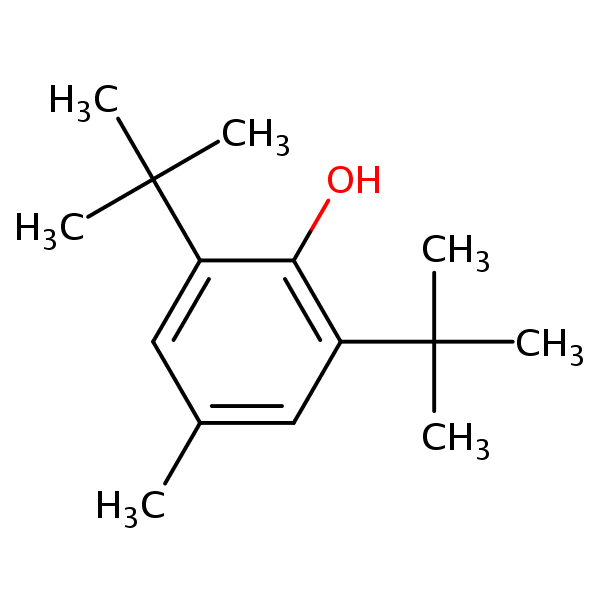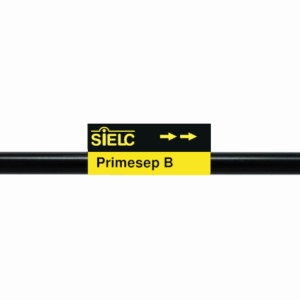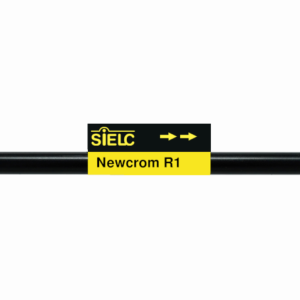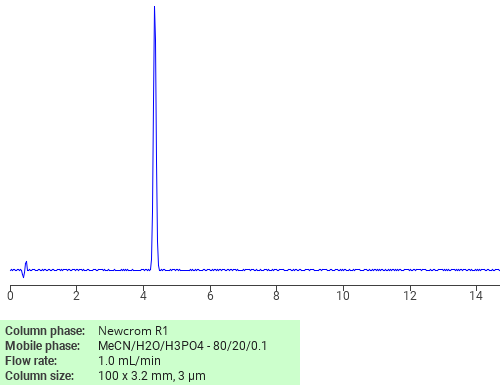| CAS Number | 128-37-0 |
|---|---|
| Molecular Formula | C15H24O |
| Molecular Weight | 220.357 |
| InChI Key | NLZUEZXRPGMBCV-UHFFFAOYSA-N |
| LogP | 5.10 |
| Synonyms |
|
Applications:
HPLC Method for Analysis of Butylated Hydroxytoluene (BHT) in Solid Deodorant on Primesep B Column
February 7, 2025
HPLC Method for Butylated hydroxytoluene on Primesep B by SIELC Technologies
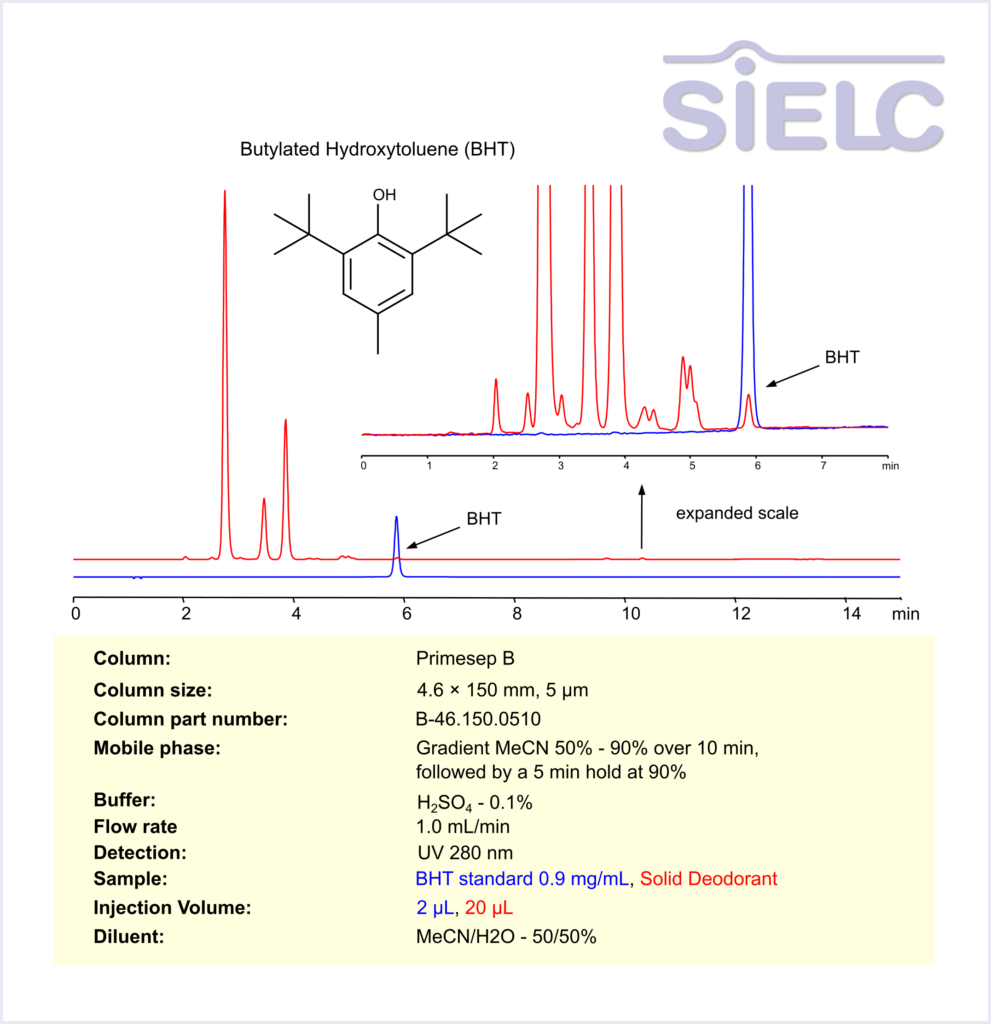
High Performance Liquid Chromatography (HPLC) Method for Analysis of Butylated hydroxytoluene
Solid Deodorant Sample Preparation:
A 2.0 g portion of the solid deodorant sample was accurately weighed and placed into a grinder. Next, 6 mL of acetonitrile (MeCN) was added, and the mixture was thoroughly homogenized. The resulting solution was filtered using a syringe filter to remove any insoluble materials.
The clear filtrate was then diluted 1:1 (v/v) with water to achieve the appropriate solvent composition for HPLC analysis. To ensure complete removal of particulates, the diluted solution underwent a second filtration using a syringe filter (PVDF 0.2 µm), yielding a final sample ready for chromatographic analysis.
Butylated Hydroxytoluene (BHT) is a synthetic antioxidant used to prevent oxidation in food, cosmetics, and industrial products. It helps maintain the freshness of oils, fats, and processed foods by inhibiting rancidity. BHT is also found in cosmetics and pharmaceuticals to protect against oxidative degradation.
While effective in preserving product quality, concerns about its potential health risks with long-term use have led to ongoing research and regulatory reviews.
Butylated hydroxytoluene can be retained and analyzed using the Primesep B stationary phase column. The analysis utilizes a gradient method with a simple mobile phase consisting of water, acetonitrile (MeCN), and sulfuric acid. Detection is performed using UV at 280 nm.
| Column | Primesep B, 4.6 x 150 mm, 5 µm, 100 A, dual ended |
| Mobile Phase | Gradient MeCN 50 – 90% over 10 min, followed by a 5 min hold at 90% |
| Buffer | H2SO4 – 0.1% |
| Flow Rate | 1.0 ml/min |
| Detection | UV 280 nm |
| Class of Compounds | Phenolic Antioxidants |
| Analyzing Compounds | Butylated hydroxytoluene |
Application Column
Primesep B
Column Diameter: 4.6 mm
Column Length: 150 mm
Particle Size: 5 µm
Pore Size: 100 A
Column options: dual ended

HPLC Method for Analysis of Butylated Hydroxytoluene (BHT) and Butylated Hydroxyanisole (BHA) on Primesep B Column
February 6, 2025
HPLC Method for Butylated hydroxytoluene, 3-tert-butyl-4-hydroxyanisole (BHA) on Primesep B by SIELC Technologies
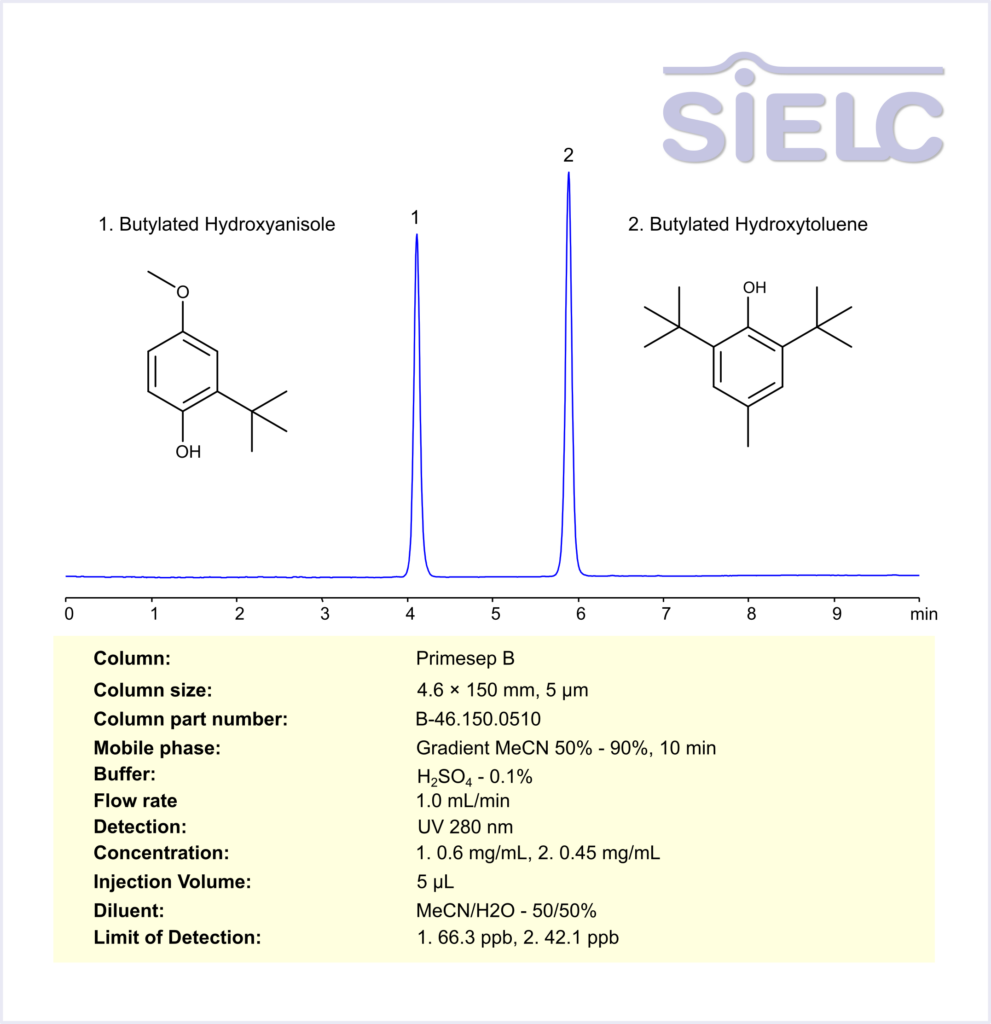
High Performance Liquid Chromatography (HPLC) Method for Analysis of Butylated hydroxytoluene, 3-tert-butyl-4-hydroxyanisole (BHA)
Butylated Hydroxytoluene (BHT) and Butylated Hydroxyanisole (BHA) are synthetic antioxidants commonly used to prevent oxidation, which can lead to spoilage, rancidity, and loss of flavor in food, cosmetics, and pharmaceuticals.
BHT is a fat-soluble compound that helps maintain the freshness of oils, fats, and processed foods by preventing them from oxidizing and becoming rancid. It is also used in some cosmetics and industrial products.
BHA is often found in processed foods, snacks, and animal feed. It helps preserve the quality of products by preventing oxidative damage that can affect flavor, color, and texture.
While both BHT and BHA are effective at prolonging the shelf life of products, concerns have been raised about their potential health risks when consumed in large quantities over time, prompting ongoing research and regulatory reviews.
Butylated hydroxytoluene, 3-tert-butyl-4-hydroxyanisole (BHA) can be retained and analyzed using the Primesep B stationary phase column. The analysis utilizes a gradient method with a simple mobile phase consisting of water, acetonitrile (MeCN), and sulfuric acid. Detection is performed using UV at 280 nm.
| Column | Primesep B, 4.6 x 150 mm, 5 µm, 100 A, dual ended |
| Mobile Phase | Gradient MeCN 50 – 90%, 10 min |
| Buffer | H2SO4 – 0.1% |
| Flow Rate | 1.0 ml/min |
| Detection | UV 280 nm |
| LOD | 1. 66.3 ppb, 2. 42.1 ppb |
*LOD was determined for this combination of instrument, method, and analyte, and it can vary from one laboratory to another even when the same general type of analysis is being performed.
| Class of Compounds | Phenolic Antioxidants |
| Analyzing Compounds | Butylated hydroxytoluene, 3-tert-butyl-4-hydroxyanisole (BHA) |
Application Column
Primesep B
Column Diameter: 4.6 mm
Column Length: 150 mm
Particle Size: 5 µm
Pore Size: 100 A
Column options: dual ended
Butylated hydroxytoluene

HPLC Method for Separation BHA and BHT on Newcrom R1 Column
March 1, 2024
HPLC Method for Analysis of Butylated hydroxytoluene, 3-tert-butyl-4-hydroxyanisole (BHA) on Newcrom R1 Column by SIELC Technologies
Separation type: Liquid Chromatography Reversed-phase
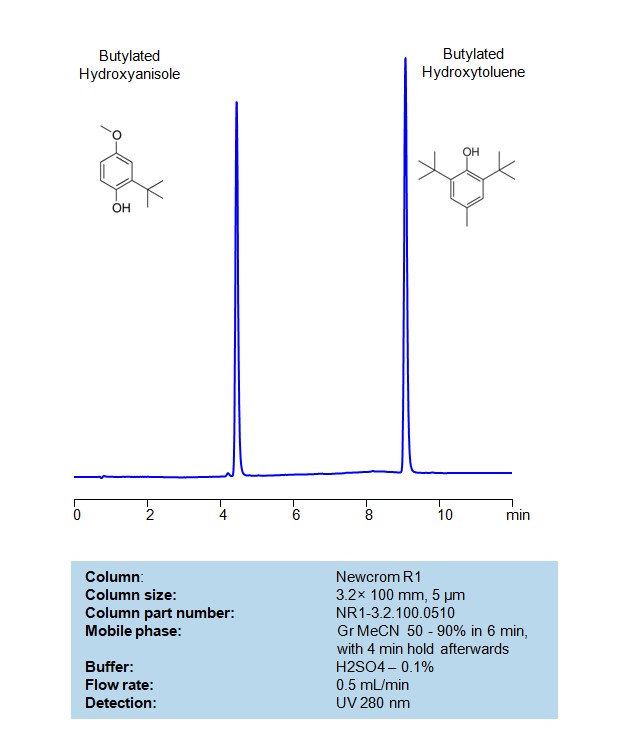
3-tert-butyl-4-hydroxyanisole (BHA) is a synthetic antioxidant commonly used as a food preservative. It is an aromatic compound with the chemical formula C11H16O2. BHA belongs to a class of compounds known as butylated hydroxyanisoles.
Function: BHA is used as an antioxidant to prevent the spoilage of fats and oils in various food products. It helps protect these substances from oxidative degradation, extending the shelf life of processed foods.
Chemical Structure: The compound has a molecular structure with a tert-butyl group (tert-butyl radical) attached to the oxygen atom of a hydroxyanisole group. The IUPAC name for BHA is 2-tert-butyl-4-methoxyphenol.
Usage: BHA is commonly used in a variety of food products, including snack foods, baked goods, cereals, and fats and oils. It is also used in certain cosmetic and pharmaceutical products.
Butylated Hydroxytoluene (BHT) is a synthetic antioxidant belonging to the class of compounds known as butylated hydroxytoluenes. Like BHA (butylated hydroxyanisole), BHT is commonly used as a food preservative to prevent the oxidation of fats and oils in various processed foods. It is also used in other products, including cosmetics, pharmaceuticals, and industrial applications.
Function: BHT acts as an antioxidant by inhibiting the oxidation of fats and oils. It helps prevent the development of off-flavors and odors in foods, extending their shelf life.
Usage: BHT is commonly used in a variety of food products, including snacks, cereals, baked goods, and processed meats. It is also used in some cosmetic and personal care products and in the packaging of certain products to prevent oxidation.
BHA and BHT can be retained, separated and analyzed on a reversed-phase Newcrom R1 column with a mobile phase consisting of water, Acetonitrile (MeCN), and sulfuric acid. This analytical method can be detected with high resolution and peak symmetry at a wavelength of 280 nm using UV detection
High Performance Liquid Chromatography (HPLC) Method for Analyses of Butylated hydroxytoluene, 3-tert-butyl-4-hydroxyanisole (BHA) on Newcrom R1 Column by SIELC Technologies
Condition
| Column | Newcrom R1, 3.2 x 100 mm, 5 µm, 100 A, dual ended |
| Mobile Phase | Gradient MeCN – 50 -90%, 6 min, 4 min hold |
| Buffer | H2SO4 – 0.1% |
| Flow Rate | 0.5 ml/min |
| Detection | UV 280 nm |
| Injection volume: | 1 µL |
| Sample | 1 mg/ml |
| Sample Diluent | MeCN/H2O – 50/50% |
Description
| Class of Compounds | butylated hydroxyanisoles (BHAs) |
| Analyzing Compounds | Butylated hydroxytoluene, 3-tert-butyl-4-hydroxyanisole (BHA) |
Application Column
Newcrom R1
Column Diameter: 3.2 mm
Column Length: 100 mm
Particle Size: 5 µm
Pore Size: 100 A
Column options: dual ended
Butylated hydroxytoluene

HPLC Method for Analysis of Butylated Hydroxytoluene on Newcrom R1 Column
December 20, 2023
HPLC Method for Analysis of Butylated hydroxytoluene on Newcrom R1 by SIELC Technologies
Separation type: Liquid Chromatography Reversed-phase
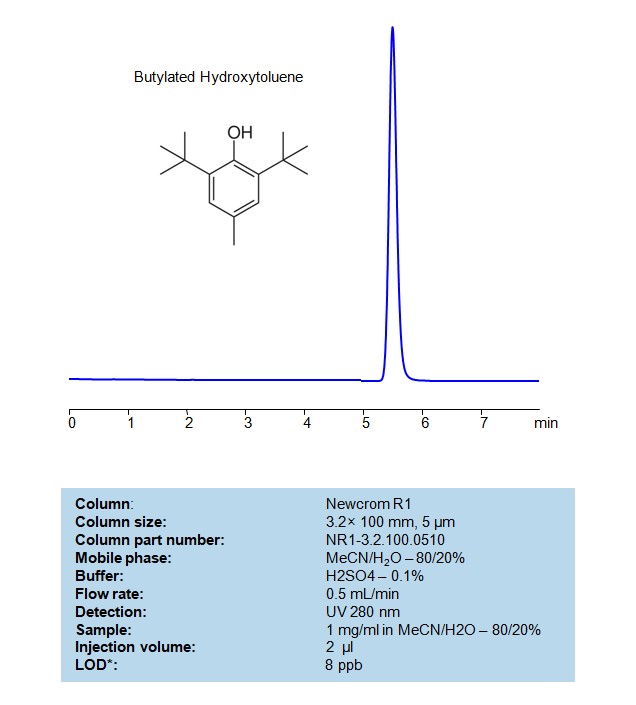
Butylated hydroxytoluene (BHT) is a synthetic antioxidant widely used in a variety of industries, particularly in food preservation, cosmetics, and industrial products.
Butylated hydroxytoluene is used primarily for preserving the freshness and quality of products by preventing oxidative degradation. While considered safe for use within regulatory limits, its potential health and environmental effects continue to be areas of study and discussion.
Butylated Hydroxytoluene can be retained, and analyzed on a mixed-mode Newcrom R1 column with a mobile phase consisting of water, Acetonitrile (MeCN), and sulfuric acid. This analytical method can be detected with high resolution and peak symmetry at a wavelength of 280 nm using UV detection.
High Performance Liquid Chromatography (HPLC) Method for Analyses of Butylated hydroxytoluene on Newcrom R1 Column by SIELC Technologies
Condition
| Column | Newcrom R1, 3.2 x 100 mm, 5 µm, 100 A, dual ended |
| Mobile Phase | MeCN/H2O – 80%, |
| Buffer | H2SO4 – 0.1% |
| Flow Rate | 0.5 ml/min |
| Detection | UV 280 nm |
| Injection volume | 2 µl |
| Sample | 1 mg/ml in MeCN/H2O – 80/20% |
| LOD* | 8 ppb |
Description
| Class of Compounds | Diphenyl ethers |
| Analyzing Compounds | Butylated hydroxytoluene |
Application Column
Newcrom R1
Column Diameter: 3.2 mm
Column Length: 100 mm
Particle Size: 5 µm
Pore Size: 100 A
Column options: dual ended

Separation of Butylated hydroxytoluene on Newcrom R1 HPLC column
February 16, 2018
Butylated hydroxytoluene can be analyzed by this reverse phase (RP) HPLC method with simple conditions. The mobile phase contains an acetonitrile (MeCN), water, and phosphoric acid. For Mass-Spec (MS) compatible applications the phosphoric acid needs to be replaced with formic acid. Smaller 3 µm particles columns available for fast UPLC applications. This liquid chromatography method is scalable and can be used for isolation impurities in preparative separation. It also suitable for pharmacokinetics.
Application Column
Newcrom R1
The Newcrom columns are a family of reverse-phase-based columns. Newcrom A, AH, B, and BH are all mixed-mode columns with either positive or negative ion-pairing groups attached to either short (25 Å) or long (100 Å) ligand chains. Newcrom R1 is a special reverse-phase column with low silanol activity.
Select options